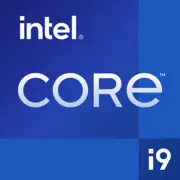Intel Core i9-8950HK

Intel Core i9-8950HK in 2025: Is it Worth Considering an Outdated Flagship?
Analysis of capabilities, use cases, and relevance of the processor for modern tasks
Architecture and Manufacturing Process: Legacy of the 14 nm Era
The Intel Core i9-8950HK processor, released in 2018, belongs to the Coffee Lake generation and is still found in some budget gaming and work laptops. Its architecture is based on a 14 nm manufacturing process, which appears archaic in 2025 compared to the 5 nm chips from Apple M3 or the 4 nm AMD Ryzen 8000 series. Nonetheless, its specifications are still impressive:
- 6 cores and 12 threads thanks to Hyper-Threading;
- Base frequency of 2.9 GHz, with a maximum Turbo Boost frequency of 4.8 GHz;
- 12 MB of L3 cache;
- Integrated graphics of Intel UHD Graphics 630 with a base frequency of 350 MHz and a maximum frequency of 1.2 GHz.
Architecture Features:
- Support for DDR4-2666 memory;
- Overclocking capability (the ‘HK’ model is unlocked);
- 16 PCIe 3.0 lanes for connecting discrete graphics or NVMe storage.
iGPU UHD 630 is a weak point in 2025. It handles office tasks, streaming video (including 4K), and less demanding games like CS:GO or Dota 2 on low settings (30-40 FPS). For modern titles like Cyberpunk 2077 or Alan Wake 2, a discrete graphics card (e.g., NVIDIA RTX 4050 or higher) is required.
Power Consumption and TDP: A Compromise Between Power and Heat
The nominal TDP of the processor is 45 W, but the actual power consumption under load can reach 90-100 W in Turbo mode. This creates two problems:
1. Heat Generation. Without an effective cooling system (such as substantial heat sinks and fans), the processor can quickly overheat, leading to throttling—reduction in frequencies to prevent damage.
2. Battery Life. In laptops with a 60-70 Wh battery, runtime under load rarely exceeds 2-3 hours.
Power-Saving Technologies:
- Intel Speed Shift — dynamic frequency management to reduce power consumption during idle periods;
- Adaptix Thermal Framework — optimization of fan operations based on load.
Performance: How Does It Handle Modern Tasks?
Geekbench 6:
- Single-Core: 1372;
- Multi-Core: 4916.
For comparison:
- Apple M1 (2020) — 2300 (Single), 8300 (Multi);
- AMD Ryzen 5 7600X (2023) — 2700 (Single), 13500 (Multi).
Real-World Scenarios:
1. Office Work (Chrome, Excel, Zoom):
The processor performs seamlessly, even with a dozen tabs and background applications.
2. Multimedia (Premiere Pro, Blender):
Rendering a 10-minute 1080p video takes about 12 minutes (compared to about 5 minutes with the Ryzen 7 7700). In 2025, this is an average result.
3. Gaming:
Paired with an RTX 4060 at Full HD:
- Apex Legends — 90-110 FPS;
- Shadow of the Tomb Raider — 75 FPS;
- Cyberpunk 2077 (without ray tracing) — 45-55 FPS.
Turbo Boost Mode:
With good cooling, the frequency maintains around 4.5-4.7 GHz, but after 10-15 minutes of heavy load, throttling down to 3.8-4.0 GHz may occur.
Use Cases: Who Would Benefit from the i9-8950HK in 2025?
1. Budget Gamers. Laptops with this CPU and RTX 4050/4060 can be found for $800-1000. For gaming at Full HD on medium settings, it's an acceptable option.
2. Professionals on a Tight Budget. Suitable for video editing, 3D modeling, and programming if maximum rendering speed is not required.
3. Users Upgrading Old Devices. If your laptop from 2018-2020 has burned out and your budget is limited—this is a temporary solution.
Battery Life: The Price for Performance
In web browsing and document work, the laptop will last 4-5 hours (with a 70 Wh battery). In gaming or under load — 1.5-2 hours. To save battery life, users can:
- Disable Turbo Boost using utilities like ThrottleStop;
- Use the "Power Saving" mode in Windows;
- Replace HDD with SSD and eliminate background processes.
Comparison with Competitors
1. AMD Ryzen 7 5800H (2021):
- 8 cores / 16 threads;
- Better multi-threaded performance (+20%);
- 7 nm manufacturing process, lower heat output.
2. Apple M1 (2020):
- Energy efficiency is 2-3 times better;
- Powerful iGPU, but limited compatibility with Windows applications.
3. Intel Core i5-13420H (2024):
- 10-core hybrid CPU;
- 30% faster in single-threaded tasks;
- TDP of 45 W, but higher IPC.
Conclusion: The i9-8950HK lags behind modern counterparts but excels in price.
Pros and Cons
Strengths:
- High performance for its age;
- Unlocked multiplier for overclocking;
- Compatibility with Windows 10/11 and Linux.
Weaknesses:
- Outdated 14 nm manufacturing process;
- Low energy efficiency;
- Weak integrated graphics.
Laptop Selection Recommendations
1. Type of Device:
- Gaming Laptops (ASUS TUF, MSI Bravo) — focus on cooling and discrete graphics.
- Workstations (Dell Precision) — large RAM (32 GB recommended) and 1 TB SSD.
2. What to Look For:
- Cooling System: at least 2 fans, copper heat pipes.
- Battery: at least 70 Wh.
- Ports: USB-C, HDMI 2.0, Thunderbolt 3.
Prices in 2025:
- New laptops with i9-8950HK — $800-1200;
- Similar models with Ryzen 5 7600H — starting from $1000.
Final Conclusion
The Intel Core i9-8950HK in 2025 is a niche solution for:
- Gamers willing to compromise between price and performance;
- Users needing a temporary laptop for basic professional tasks;
- Enthusiasts experimenting with overclocking on a budget platform.
Key Benefits: low cost, proven reliability, compatibility with most software. However, for long-term prospects, it's better to consider ARM models (Apple M series) or modern hybrid CPUs from Intel/AMD.
Basic
CPU Specifications
Memory Specifications
GPU Specifications
Miscellaneous
Benchmarks
Compared to Other CPU
Share in social media
Or Link To Us
<a href="https://cputronic.com/cpu/intel-core-i9-8950hk" target="_blank">Intel Core i9-8950HK</a>